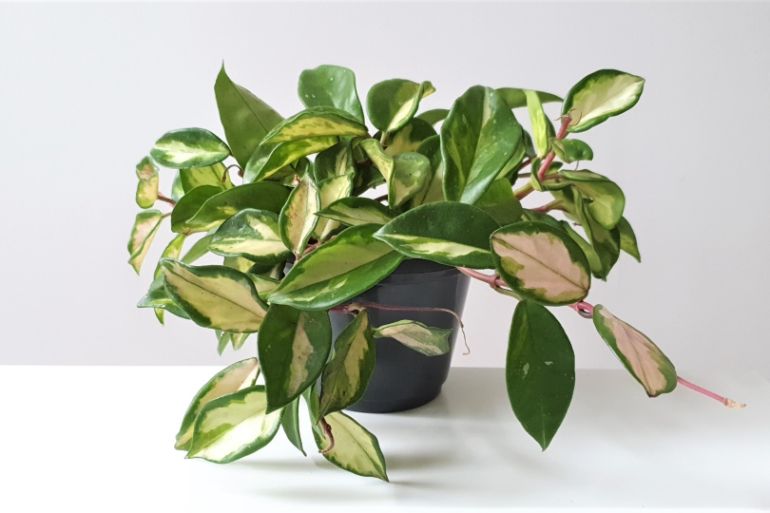Hoya australis has long been popular in its native Australia and the plant’s reputation is spreading over the globe. It’s a friendly Hoya for beginners with many excellent varieties to choose from. In this article, I will explain everything you need to know about Hoya australis care, as well as how to fix and prevent common problems.
Hoya australis needs bright, indirect light, and should be planted in a loose, well-draining potting mix. Water once the top 2-3 inches of soil feel dry, provide humidity of at least 40%, maintain temperatures of 65-80°F (18-26°C), and fertilize every 2-4 weeks during the growing season.
Hoya Australis Overview
Hoya australis is a wonderfully hardy, climbing, twining vine with lots of personality. They grow at a moderate pace and have some resistance to disease, pests, drought, and cold.
This rambling epiphyte lives naturally in rocky areas and along the edge of rainforests in East Asia and Australia. It’s a long-lived member of the Apocynaceae family that was first officially collected in 1770 from the coast of northeast Australia. Other common names include Porcelain Flower, Waxvine, and Honey plant.
The Australis is equally happy climbing a support or trailing from a basket: its slender vines can reach 13-33 feet long (4-10m)! The plant blooms in lovely clusters of white, red-tinged flowers that have a spicy-sweet fragrance and are prized for attracting butterflies. Their scent is strongest in early evening.
The basic Hoya australis leaf is oval and has a shiny, waxy finish. New foliage is red-hued and turns green as it matures; the leaves can show a gold tint under high light. The different varieties have many differences: the leaves may be thinner or have a different shape, size, fuzziness, etc.
Hoya Australis Care Summary
| Scientific Name | Hoya australis |
| Origin | Borneo, Fiji, New Guinea, Australia, SW. Pacific Islands |
| Light Requirements | Provide mainly bright, indirect light. A few hours of early morning or late afternoon sunshine can help improve the chance of blooming. |
| Watering | Water once the top few inches of soil dries out. Can tolerate drought, but won’t tolerate overwatering. |
| Soil | Naturally epiphytic, so demands a loose, well-draining potting mix. I prefer to use equal parts coco coir, perlite, and orchid bark, with about 10% worm castings to improve soil fertility. |
| Temperature | Does best in temperatures of 65 – 80°F (18 – 26°C). Avoid exposure to temperatures below 45°F (7°C). |
| Fertilizer | Feed every two to four weeks with a well-balanced fertilizer during the growing season. |
| Humidity | Keep humidity above 40%. More tolerant to lower humidity than some Hoyas. |
| Flowering | Produces exquisite bloom in three-inch wide clusters containing dozens of small, white, star-shaped flowers with pink or red centers. Most likely to bloom in late summer/autumn. |
| Pruning | Prune dead leaves as necessary, but avoid major pruning, as this tends to more harm than good. |
| Propagation | Stem cuttings can easily be propagated in soil or water. Propagate in spring or early summer for best results. |
| Re-Potting | Only needs repotting once significantly rootbound. Only increase pot size by 1-2 inches. |
| Diseases and Pests | Can be affected by aphids, scale, spider mites, thrips, and mealybugs, but will tolerate mild infestations without excessive damage if treated early. Not very prone to disease except root rot and fungal leaf diseases if overwatered. |
| Toxicity | Non-toxic to people and animals. |
| Where To Buy | Buy Hoya australis online at Etsy (I buy most of my houseplants from Etsy). |
Hoya Australis Light Requirements
Hoyas are often advertised as tolerant of low light, but this isn’t quite the full picture. Hoya australis can survive in less light than they need for strong growth and flowering. They won’t bloom in a dim corner, though.
The need for light can vary among the Australis varieties: for example, the Rupicola comes from harsh, stark terrain and can tolerate more direct sun than its cousins.
Hoya australis is on the light-loving side of the Hoya spectrum. They enjoy a few hours of gentle morning sun. In northern climes, the plant can benefit from even more direct sun.
Increasing light is the first aspect of Hoya australis care to adjust if your Hoya isn’t producing flowers. If you want to see your Australis bloom – and you do! – make sure it gets plenty of bright lumens during the growing season.
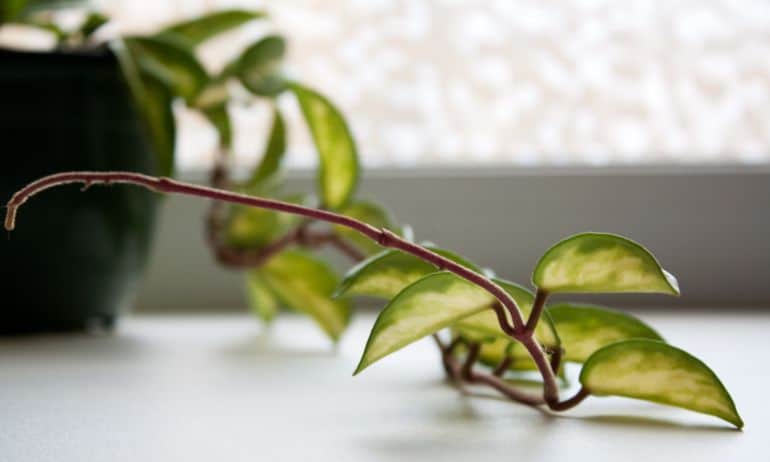
Other lighting tips:
- Increasing the plant’s light generally increases its water consumption: strong light helps keep the soil from staying moist for too long.
- Too much direct sunlight will scorch the plant’s leaves.
- Artificial illumination can be effective.
- Mild direct sunlight is welcome if the rays are not intense. Your latitude determines the sunlight’s intensity.
- One sweet spot for light indoors is two to four feet in front of a sunny window. This includes south-facing exposures.
- For some guidance on how to place your Hoya australis in good lighting in your home, read my guide to lighting for houseplants.
It’s Not You … It’s Moving
One quirky thing about the Australis is that its tendrils are quite active … they travel in circles looking for something to climb. They move well over a foot a day, so it’s a lively plant.
This behavior, multiplied by the number of tendrils waving in all directions, can be seen as charming or eerie and Medusa-like. If the wayward tentacles unnerve you, give each searching vine a cord or other support to climb—it’s better than cutting them off and stifling the plant’s growth.
The bare tendril will sprout leaves once it feels established.
How To Water Hoya Australis
Hoya australis has medium to low water requirements and can take short droughts without an issue. As an epiphyte, it prefers having well-oxygenated roots.
The plant has deliberate adaptations to low water conditions. Its leaf pores, or stomata, close during the day to conserve water; they open at night to breathe. Their leaves store (a little) water, too.
Underwatering is always better than overwatering for providing good Hoya australis care; avoiding root rot is a horticultural priority. Yellow leaves are an early warning sign the plant’s roots are struggling with too much water.
The leaves also crinkle and fold as they dry out and need water. They will bounce back, though … if you don’t push things too far!
The plant requires different watering schedules for different times of the year.
Summer – Your Hoya australis is a thirsty plant during the growing season. In warm weather, it wants the soil to stay slightly moist. Wait until the top one to three inches of soil dries (depending upon the pot size) … when it’s time to water, saturate the mix well. Run extra water through to flush it.
Winter – The Australis enters sleep mode during the colder months and uses little water. Continuing with the same schedule will lead to overwatering. Instead, let the soil dry out more before watering again, and only give the plant enough to moisten the rootball as needed.
Other tips:
- Watering is the trickiest aspect of Hoya australis care to get right. Check your plant every few days and only water when you’re sure it needs a drink.
- Some varieties need less water than others: learn what your plant likes.
- Check the soil before watering your Australis, don’t follow a set schedule.
- Hoyas can be sensitive to contaminants and may develop discolored leaves if the tap water is highly mineralized. Always dechlorinate, and consider using filtered water or rainwater.
- Check out my article on mastering the art of watering houseplants to make sure you know exactly when and how much to water your Hoya australis.
Hoya Australis Soil Requirements
Your Australis’ soil is very important. In some ways, the less of it the better: the plant is challenged in heavy soil. A soilless mixture can work well because it drains efficiently and doesn’t get soggy.
Combinations of peat, coco coir, compost, perlite, orchid mix, and quality cactus soil all preserve fertility and regulate water retention. Orchid bark is a good way to texturize the soil and keep it airy.
The exact mixture is up to you … here are ideas:
- I prefer to use equal parts peat/coco coir, orchid bark, and perlite. I often add 10% worm castings to improve soil fertility.
- Peat moss and perlite, with or without coco coir.
- Cactus soil, orchid mix, and perlite.
- The properties of the soil are more important than the exact ingredients. Read my guide to choosing and making houseplant soil for more info.
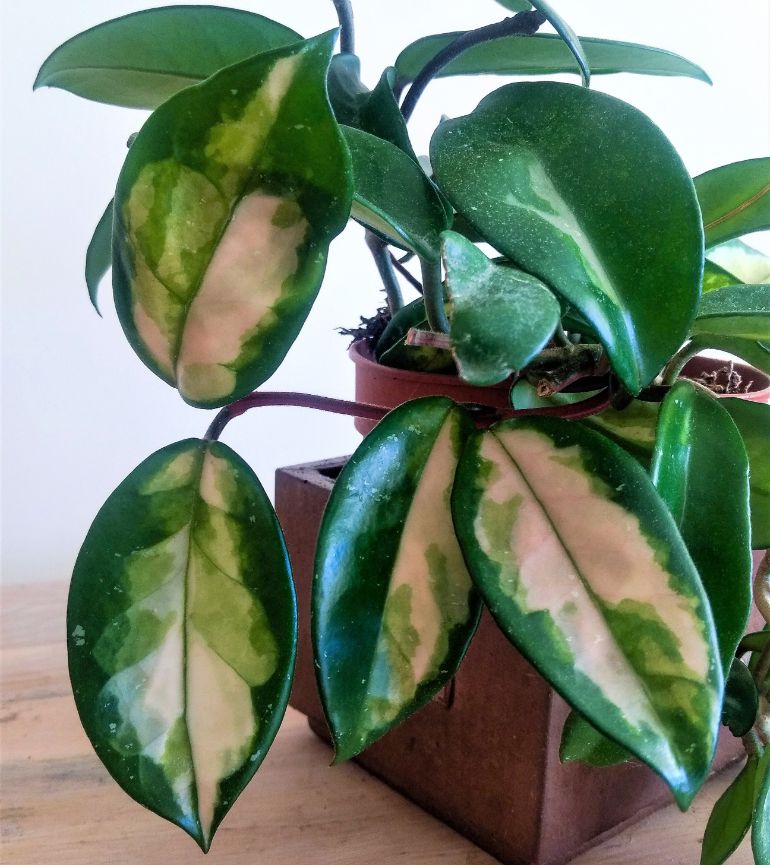
Humidity For Hoya Australis
Most Hoyas prefer humidity over 60% … but this is one of the more tolerant members of the species. Hoya australis can cope well with average humidity down to about 40%.
Signs of low humidity stress are slow, lackluster growth and brown dried patches on leaves.
Many growers live in average humidity and don’t try to increase it, and their Hoya australis copes well with no visible effects. This can change over the winter when artificial heating dries the air further. Be prepared to step in and bump up the humidity to counteract this effect.
Temperature Requirements
The Australis is a warm-weather plant that enjoys a range of about 65 – 80°F (18 – 26°C) in the growing season. It has light resistance to colder temperatures, more than most Hoyas – but they are still tender tropicals that wither in a frost.
Outdoors, the plant can grow year-round in USDA Zones 10 and 11. Many growers keep their Australis outside during the warm months and bring it inside once the outer temperature falls below 50ºF (10ºC).
- Don’t let the plant’s air temperature fall below 45°F (7°C).
- The plant’s growth begins to slow down at 68ºF (20̒ºC).
- Avoid drafts and temperature extremes.
How To Fertilize Hoya Australis
Hoyas are not heavy feeders overall, but providing some light feeding during the growing season is still an important aspect of Hoya australis care.
The most common recommendation is to feed every two to four weeks with a well-balanced organic fertilizer. Organic sources provide not only nutrition for the plant, but also nourishment for the teeming microbes in the soil that indirectly support the plant’s health.
Another benefit of organic fertilizer and other matter is that it naturally provides trace micronutrients and macronutrients. A well-balanced synthetic fertilizer that includes these important elements will be more expensive – though maybe still not as pricey as organics.
Fertilizing Tips:
- Synthetic fertilizers are more concentrated and therefore likely to burn roots if not sufficiently diluted. It is best to weaken the formula to half or quarter strength with water before applying.
- An orchid foliar fertilizer can be effective.
- A slow-release fertilizer is another option, but don’t overuse.
- Flush the soil regularly to avoid a toxic buildup of residue chemicals.
- Read my guide to fertilizing houseplants to learn everything you need to know about feeding your houseplants.
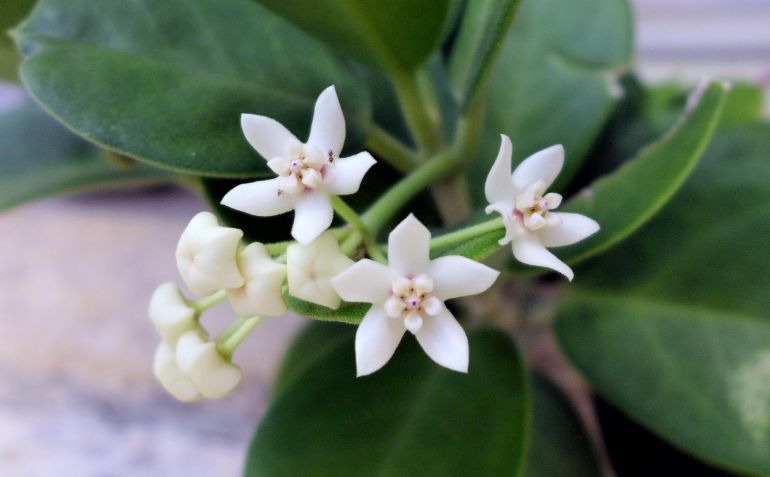
Hoya Australis Flowers
Flowers are the feature that pushes Hoya australis into greatness. They bloom in three-inch wide clusters containing dozens of small, white, star-shaped flowers with pink or red centers. Each smooth, exquisite flower looks to be crafted from wax or sugar icing.
The fragrance of the flowers is described as spicy chocolate; it is strongest in early evening. Seed pods develop after the flowers. The inflorescence exudes sticky drops of nectar, so protect the furniture.
Though an Australis is considered a late fall to early winter bloomer, it can flower in spring and other times. Though the plant is often lauded for its robust, almost continuous blooming, some owners of seemingly healthy plants never see a flower.
To help stimulate blooms, increase the light and give them cooler temperatures at night. If you still aren’t seeing blooms, try giving the plant a month or two of temperatures about 10ºF below its normal range. A proper dormancy can prompt flowers.
Pro Tip: Some growers use a “bloom booster” with extra phosphorus when the plant is about to flower.
Pruning Hoya Australis
Pruning isn’t really a thing when it comes to Hoya australis care. It doesn’t stimulate the plant into making new growth – if anything, the blow stuns it – and you might trim future peduncles that would have bloomed. It also reduces the energy the plant can produce.
This is especially true if you have a smaller plant. Those lively leaves add energy: the Australis produces new growth briskly with the right resources and conditions. If you want the plant to fill out quickly, leave the foliage to do its job.
Pruning away dead or damaged material is safe and won’t hurt the plant. It clears away potential havens for pests and decay pathogens.
Giving your Australis a spring checkup is a good practice. Trim stems that are weak or producing inferior leaves. Removing material makes room for healthy growth in the warm months ahead.
How To Repot Hoya Australis
Hoya australis doesn’t need to be repotted frequently; every two years is typical.
Root disturbance bothers Hoyas; fortunately, Hoya australis is an epiphyte that lives naturally in borrowed spaces and finds a snug pot quite cozy. Only repot when the roots have filled the pot and consumed a significant part of the soil.
- Spring is the best time to repot.
- Only go up one pot size at a time.
- Water the plant the day before repotting: well-hydrated roots are more pliable and resilient.
- Don’t fertilize for six weeks after repotting to avoid shocking tender new roots.
- Read this step-by-step guide to repotting rootbound houseplants for more info.
How To Propagate Hoya Australis
Ease of propagation is another reason for the popularity of Hoya australis. It can be grown from seed, but cuttings are quicker and easier.
The best time to take cuttings is during late spring or early summer. They can be rooted in water or placed directly into soil.
There is evidence that water-grown roots don’t function as well out of that medium and must regrow in soil … watching roots sprout is fun and removes the guesswork, however, so many growers use this method anyway.
Simply put the cutting into clean and dechlorinated water, give it warmth and good indirect light, and wait for the cutting to sprout a small root system.
Whether you are planting a fresh cutting or one with water-sprouted rootlets, the next steps are the same.
- Fill your planting tray or pot with a sterile mix of perlite, vermiculite, or clean sand to ensure drainage. Water well and set aside to drain.
- Cut a four-to-six inch portion of healthy stem. Include two or three leaves; at least two nodes must be present to propagate.
- Remove the lower leaves and gently plant the stem. Make sure the leaves don’t touch the soil.
- Put the pot in indirect sunlight and keep the cutting warm. Water regularly to keep the soil slightly moist.
Additional Aids
Your defenseless Hoya australis cutting is vulnerable to both decay and drying out. There are a few tricks that can help it win the race against rot:
- Rooting hormone can work wonders on a recalcitrant plant. Dip the stem in rooting hormone before planting; either liquid or powdered is fine.
- Covering the pot with plastic or using a propagator will increase the humidity and keep the soil more evenly moist.
- Heat mats placed underneath the cuttings can help speed the rooting process.
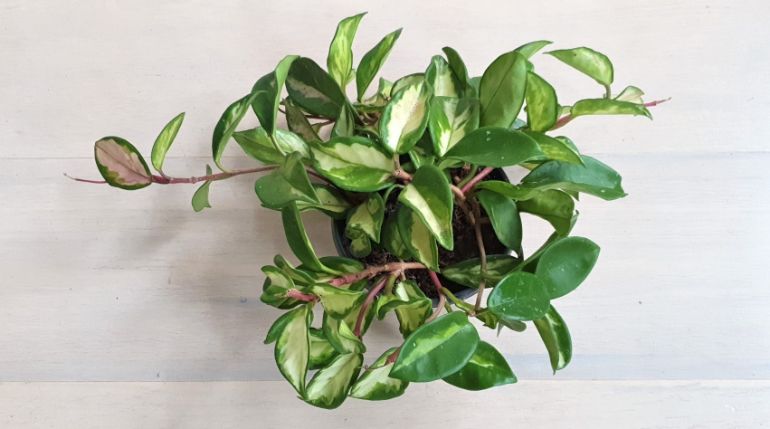
Hoya Australis Care Tips
- Hoya australis is healthier and longer-lived if given a cool dormant season each year. (They aren’t machines, people!) A protected porch or cool basement with artificial light are two options.
- Hoya’s demand for water skyrockets during a growth phase or when preparing to flower.
- Make sure the plant has good airflow around it to reduce the stagnant moisture that breeds fungus and other problems. (Don’t put them in a draft, though.)
- Sometimes Hoyas put out misshapen or “highly individualized” leaves. As long as the inharmonious foliage isn’t signaling the plant’s distress, consider it part of the Hoya charm.
- Hoya australis care can be negatively affected by moving your plant, so you might need patience while your new friend adjusts.
- Don’t relocate the plant while it’s blooming, if possible. Its energy reserves are otherwise committed.
- Instead of pruning long vines, consider wrapping them in looping circles around the plant. This retains the plant’s energy-creating leaves for better growth and flowering.
Toxicity
Hoya australis is a safe snack for horses, cats, and dogs in modest amounts. Most growers’ expensive and precious, coddled Hoyas are small enough to be consumed without an issue.
The plant is safe for people, too – but it can cause a tummy-ache if too much is eaten at once.
Varieties
You have a lot of choice with this plant. Many of the excellent varieties of Australis come from semi-isolated islands within its range, and wonderful hybrids have been bred over many decades of cultivation.
Here are well-known cultivars:
‘Grande’: This variety has extra-large, dark green foliage and star-shaped blooms with unique wavy petals.
‘Kapaho’: The glossy, medium green leaves start out slender and pointy and become rounder as they grow. The flowers have slender petals.
‘Lisa’: Highly popular variegated cultivar that features broad swathes of cream to white variegation. It grows slowly but is easy to care for.
‘Oramicola’: This fragrant bloomer has leaves that are smaller and more elongated than many Australis varieties. It favors drier conditions.
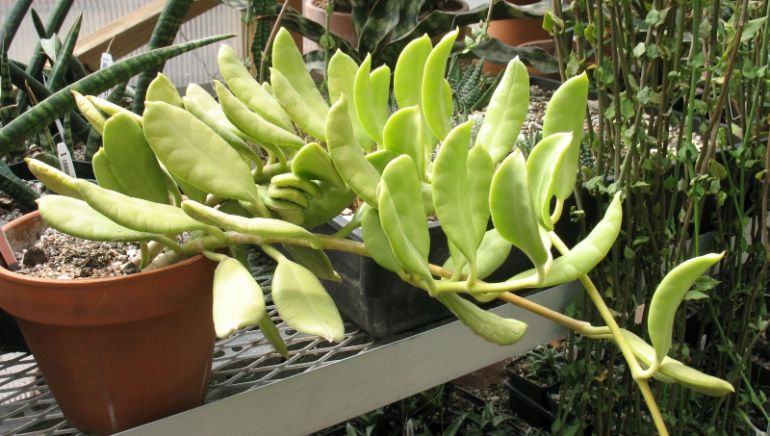
‘Rupicola’: This distinctive rambling vine naturally lives among rocks … its long, pointed leaves are rugged and can take more intense sunlight than most Hoyas.
‘Subspecies’: This botany puzzle was reclassed to its own subspecies without being given an actual name. It’s a popular, attractive, and easy-to-keep species that reliably produces large clusters of sweetly fragrant flowers.
Tenuipes: This fetching round-leaved species is popular for its glossy foliage and sweetly scented, medium-sized blooms.
These are just a few standout Australis varieties … other contenders include the Australis Sana, Sanae, Keysii, Tonga, and the unhelpfully named Hoya Australis ssp. Australis.
Note: The differences between species can be hard to discern. Sometimes the only way to know for sure is to wait until flowering.
Hoya Australis Pests
Hoya australis care can be disrupted by the usual unlovable cast: aphids, scale, spider mites, and thrips. One particularly persistent form of scale is the nook-hiding mealybug that resembles small patches of cotton on the undersides and joints of the foliage.
A weekly shower helps knock off intruders and discourages the dry-loving spider mite. It’s also a good chance to inspect the plant for pests. Even if you skip the shower, routine pest inspections are important! Getting to an infestation early makes it much easier to treat.
If you do find an infestation, repeated treatment using a light horticultural oil or insecticidal soap usually brings it under control. Some growers prefer spraying the bugs with a dilution of 9 parts water to one part isopropyl (rubbing) alcohol. Test discretely on a leaf and wait a few days to make sure it doesn’t discolor or show other damage.
Keep in mind that pest issues are often a sign of a plant being stressed in some way. The best preventative to pest problems is a healthy plant. Read my guide to identifying, treating, and preventing common houseplants pests to learn more.
Diseases
Healthy Australis plants aren’t susceptible to disease, but wet conditions can promote fungal issues and related leaf spot or other blight.
Misting is a bad practice for this reason, especially in an enclosed area. Always provide good air circulation.
Hoya Australis Care Problems
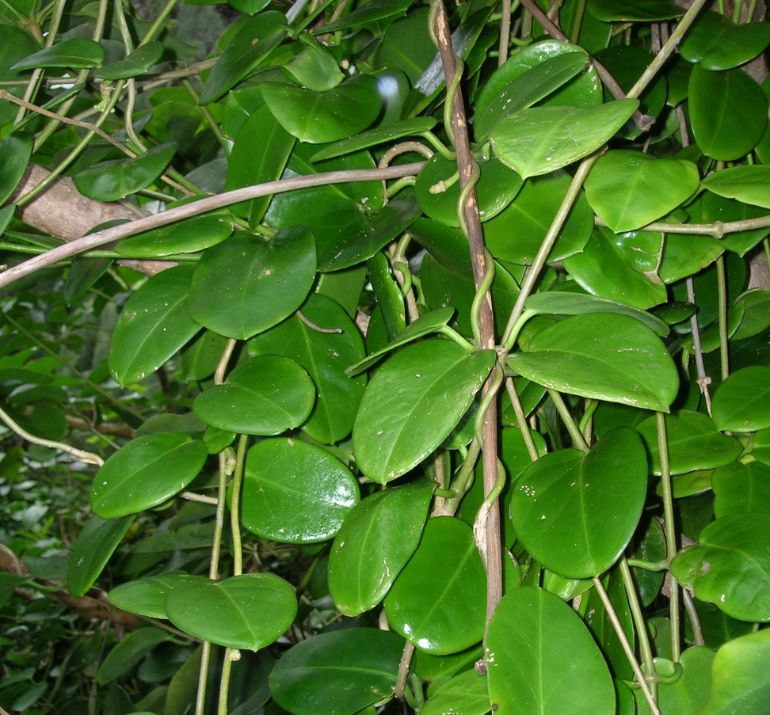
Why Are The Leaves On My Hoya Australis Turning Yellow?
Overwatering is by far the most likely cause of yellow leaves on your Hoya australis. This is most likely to affect the lower leaves first. Yellowing of the upper leaves can be a sign of excessive direct sunlight. Other causes such as temperature stress, transplant shock, and acclimation can also cause yellow leaves.
I’ve written a complete article on fixing and preventing yellow leaves on Hoyas, which should help you get your plant back to perfect health.
Why Do The Vines On My Hoya Australis Not Have Leaves?
This can be totally normal. Your plant sends out leafless vines to find sunlight and something to climb. Eventually, the bare tendril will probably start to grow leaves … but sometimes home base decides to terminate the branch and abandon operations.
Be careful with the growing tips of these tendrils: they are easy to accidentally damage, and if the tip is damaged the potential new branch will die.
Why Has My Hoya Australis Stopped Growing?
Lackluster or stagnant growth could be a reaction to a move or other change in their environment. Be aware your Hoya australis can go dormant outside the normal seasonal cycle, too.
Don’t try to water or fertilize the plant into action! That would likely make things worse. Give the plant good care and time to adjust to any recent changes, and be patient as it recovers.
Wht Is My Hoya Australis Not Flowering?
The Australis has a reputation for blooming reliably, but some growers don’t have luck. Temperature and light have an outsized role in stimulating blooming.
Here are things to try:
- Try increasing the light (without scorching the foliage).
- Drop temperatures about 10ºF overnight.
- Dropping your Australis’ temperature ten degrees during the six weeks before spring is the usual recommendation. Artificially maintaining temperatures can be tricky, but the plant likes a cooler range during dormancy.
- Be diligent about restricting the plant’s water during dormancy, too. Don’t let the soil go completely dry. Begin normal watering when you bring the plant back into warmer, brighter conditions in early spring.
Why Is My Hoya Australis Dying?
The most likely cause of a Hoya australis dying is root rot. This can be due to excessive watering, poorly draining soil, or using a pot that is too large or with insufficient drainage holes. Bear in mind that your Hoya will need much less water during winter, or in low light conditions.
Related Articles
This whole site is dedicated to helping people like you grow healthier houseplants. If you’d like to learn more about how to keep your Hoyas healthy or want to improve your indoor gardening skills, check out the following articles.

